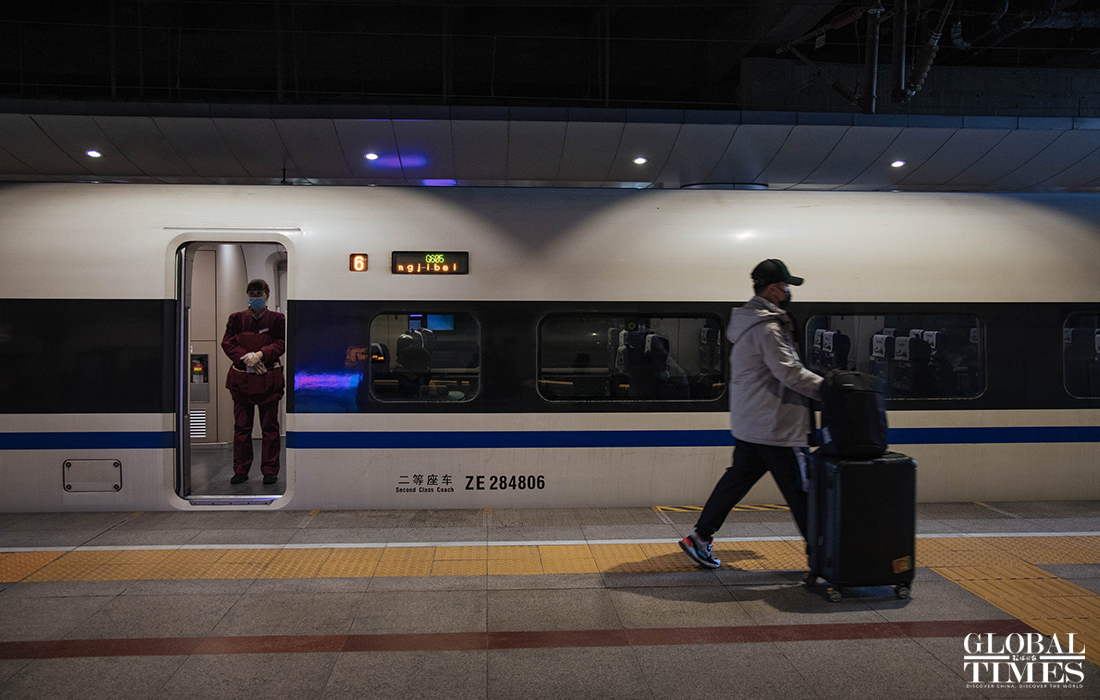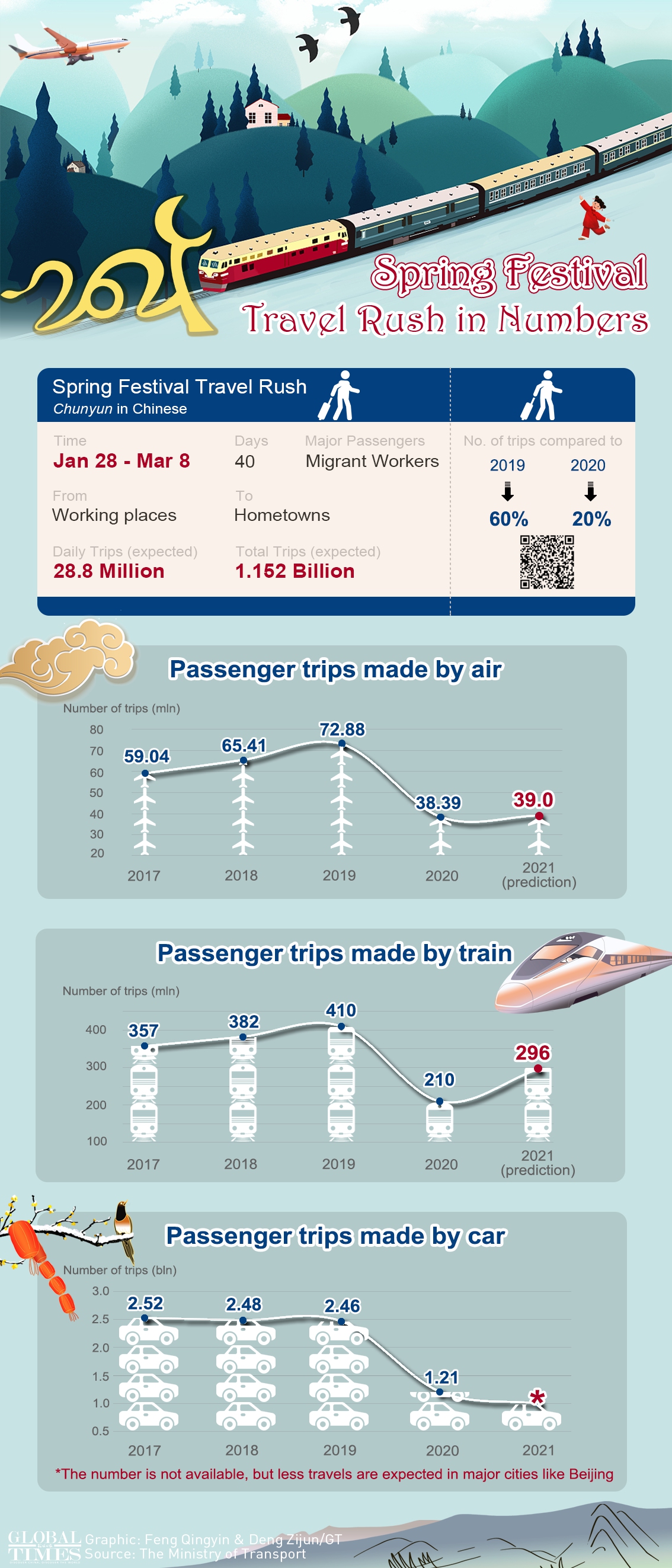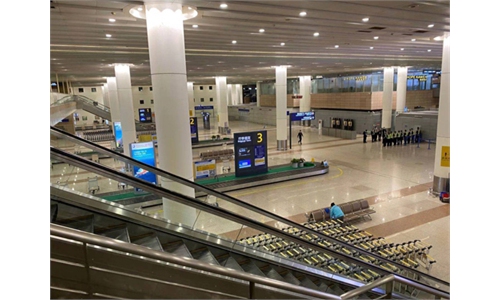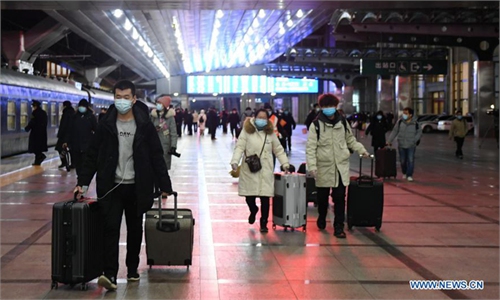
Photo: Li Hao/GT
On Thursday, the first day of China's yearly Spring Festival travel rush, which is usually the world's largest human migration, 551 flights carrying 37,600 passengers are scheduled to depart from or land at Beijing Capital International Airport, representing only 13.7 percent of the first day of the travel rush in the previous year.
On the first day of last year's Spring Festival travel rush - January 10, 2020 - the number of passengers travelling through the airport was 273,600.
The airport is expected to see a total of about 22,000 flights with 1.93 million passengers during the travel rush this year, a 60 percent decrease in passenger numbers and 40 percent decrease in flights compared to the same period in 2020, media reported.
At the Beijing Daxing International Airport, 207 flights with 16,000 passengers were scheduled for Thursday.
The scenes at Beijing's airports are a reflection of how China is cautiously conducting and guaranteeing population mobility amid the epidemic for what some said the "bleakest Spring Festival travel rush," with similar scenes witnessed across the country.
On Thursday, the Chinese Ministry of Transport said that China's 2021 Spring Festival travel rush is estimated to see around 1.152 billion trips, around 60 percent lower than that of 2019.

2021 Spring Festival Travel Rush in Numbers Infographic: Feng Qingyin & Deng Zijun/GT
Governments at all levels have recently been encouraging people to stay where they work instead of going back to their hometowns for the holiday, which may have led to the sharp decline of trips during the eight days from January 20 to 28.
But many Chinese will still go back home for a family reunion despite the difficulties and infection risks.
A woman working in Beijing surnamed Wang told the Global Times that since she spent the last Spring Festival abroad on her own, she would do anything to get home this year.
Wang's hometown is Changchun, Northeast China's Jilin Province, which is also experiencing a COVID-19 outbreak. She bought a train ticket on February 9.
"The situation has been put under control in both Changchun and Beijing. There is nothing to stop me from going home," Wang said, noting that "if anything, it would be my destiny to get infected. "
Railway stations and airports across the country are also enhancing measures to curb infections.
Beijing West Railway Station has arranged a series of epidemic prevention and disinfection measures, including setting up a total of 37 infrared thermometers at the entrance and exit of the station where passengers must have their temperatures checked, setting up a "one meter line" in crowded areas to remind passengers to keep a safe distance, and strengthening inspection, maintenance and disinfection of the venues' air-conditioning to ensure good ventilation.
The volume of arrivals in Beijing West Railway Station is expected to reach its
Spring Festival holiday peak between February 16 and 18, with a daily average of 70,000 passengers. The travel rush period of arrivals will last from February 27 to March 2, with a daily average of around 50,000 passengers, Global Times learned from the station.
The station has also intensified its disinfection efforts, including boosting disinfection of toilets during peak hours and increasing the frequency of disinfection of walls, floors, elevators, escalator handrails, gates, and passenger seats.
In order to bring more convenience to passengers, non-contact elevators have been introduced in the station, free mask pick-up machines have been installed and guide staff have been deployed in the waiting hall to answer passenger inquiries promptly.
On Thursday morning at Shanghai Hongqiao Railway Station and Hongqiao Airport, the Global Times reporter saw that passengers were wearing masks while being very cooperative with the epidemic prevention work being carried out.
Little traffic was seen in the waiting hall of the railway station.
The Shanghai Spring Festival Transport Office predicted that 35.7 million passengers are expected to travel in or out of Shanghai during the 40-day travel rush.
The volume shows a large rebound from that in 2020, but there is still a certain drop compared with 2019, according to the office.
Lü, a postgraduate student studying in Shanghai, just returned home to Jinhua, Zhejiang Province on Wednesday.
She told the Global Times that she decided to go back home before the Spring Festival as she was afraid that local anti-epidemic policies might change and require inbound travelers to be quarantined after January 28.
"But I wasn't afraid of getting infected as the prevention and control process is extremely strict at the station," Lü said, noting that "on the contrary, I felt safe in the station."
"On the one hand, people behave themselves and everyone was wearing a mask. One the other, there were staff checking their health code and taking temperatures," she said.
According to Lü, enhanced measures had not prolonged her check-in. "It took the same time to get on the train," she said.


